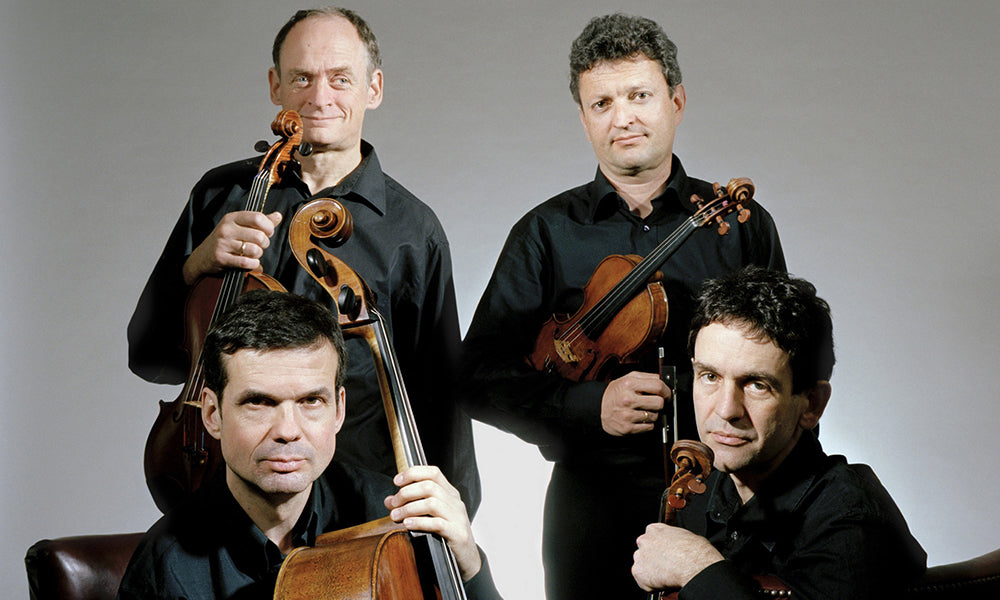
Audiophile Audition: Brahms - String Sextet No. 1 in B-flat Major; String Sextet No. 2 in G Major
Recorded 9-11 February 2014, these realizations of the two Brahms string sextets share with us a profound and often melancholy – and contrapuntal – intimacy. The Quatuor Sine Nomine opens with the 1865 G Major Sextet, composed in the spirit of “atonement” for a failed engagement between Brahms and Agathe von Siebold, daughter of a university professor. Much in the manner of mentor Robert Schumann, Brahms wove an anagram of Agathe’s name into the fabric of the first movement, A-G-A-H-E, wherein the “H” translates into B-flat. The Allegro non troppo plays upon the Agathe theme rising fifths, employing an imitative Baroque counterpoint that exploits the rich sound of the two cellos. The lulling main theme achieves a true “orchestral serenade” texture, often in three or five parts, then expanding to six. The intensely layered textures move to a ravishing, sonorous coda.
The Scherzo, in duple time, begins at a leisurely, delicate pace in the Agathe rhythm and soon interjects canonic entries. An eerie melancholy ensues to serve as a transition to a wild trio section, much in the spirit of a Slavonic dance. The da capo features plangent harmonies from the added viola and cello. The slow movement, Poco adagio, presents an anxious theme with five variations and a coda, although the Austrian critic and Brahms supporter, Eduard Hanslick, famously characterized the procedure as “variations on no theme” because of the non-descript bass line. The first four variations grow increasingly animated; the calmer fifth gives rise to the coda. The dark tone of the lower strings seems to point to the post-Romantic “school” of Max Reger and young Arnold Schoenberg. The strongly contrapuntal finale, Poco allegro, gives us a rondo in sonata-form with a fugato development section. The cantering melody divides the body of strings often in a cross between the Mendelssohn and Schumann styles. The lush contrasts of textures – tremolo, pizzicato, legato in enchanted harmony – motivated conductor Hermann Levi to exalt the piece as “the most perfect work of chamber music since Beethoven.”
The Op. 18 Sextet in B-flat Major (1860) opens with a magnificent cello melody in cross-rhythms against the body of strings, which proceed to extend the main idea through triplet figures. The full sonority in six parts comes at measure 23. The violas and cellos, again, play at varying metric units, and so introduce a nervous agitation to the otherwise unworldly lyricism. The addition of Pache’s viola contributes a dark melancholy to the texture that quite resonates with an elastic beauty. At the recapitulation we have a real cello song, a tragic utterance worthy of Schubert, from Guye’s cello. The D Minor Andante ma moderato, a theme and variations, first proffers its potent theme in the violas then the violins. More than a commentator has found traces of both La Folia and Schubert’s Death and the Maiden coursing through the theme’s veins. A hearty energy, tinged by pained lyricism, suffuses the Quatour Sine Nomine’s traversal of this often tempestuous series of variants. When the calmer moments arise, they achieve a Mediterranean transparency as piquant as the more somber episodes.
The rollicking F Major Scherzo most resembles a rustic serenade. If the first theme saunters, the ensuing material flies in cheerful harmony. Once more, Brahms reverts to musical pairs for his optimistic finale, Poco allegretto e grazioso, which often lends a rustic drone bass to the proceedings. The two extreme registers, high violins and deep cellos, play off each other and then yield to the mellow violas as a lyrical commentary. A Viennese grace – almost from Schubert’s B-flat Sonata, D. 960 – permeates the entire wash of tender sonorities, although for a contrapuntal moment we enter Beethoven’s preserves.
The two sextets have received most affectionate service, in wonderfully warm sound, courtesy of Recording Engineer, Alfredo Lasheras Hakobian.
Article's source: Audiophile Audition, December 6, 2014, by Gary Lemco
Online
iTunes
Spotify
Amazon Music
GooglePlay
Qobuz
Collections
5 Diapason
Available online
Cello
Chamber
Claves picks
François Guye
Johannes Brahms
Nicolas Pache
Pizzicato.lu - Supersonic
Popular products
Quatuor Sine Nomine
Releases 2012 - 2014
Viola
More links
Discography
Quatuor's website
More articles about this quatuor








Commentaires
0 Commentaires